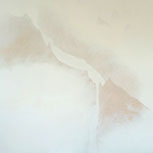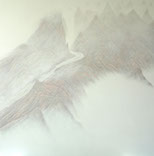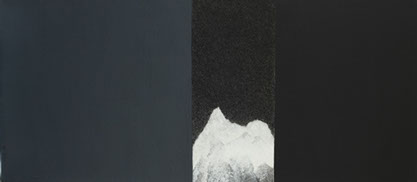窗



“秋水”行吟图
张平杰
评论家 / 策展人
纽约莱克基金会影像与视觉艺术高级研究员
上海同济大学新媒体艺术专业客座教授
与之外相识二十馀年,看他的作品从浓笔重墨的抽象渐入物我两忘的镜像。此间除了画风的演变,更是人生轨迹、思维观念的感悟。之外向来对中、西哲学素有研究,特别是禅宗与“空”的命题。在他近几年的作品中,几乎都在淡泊与宁静中观“空”,其早期抽象作品是形式的空;近期的山川空濛图式则是精神内观的“空”。之外在这些图式中找到了其精神的切合点。恍兮惚兮,生於尘世,却又隔著尘世观象,“以物观物,理解到物各自有其本性,从而忘乎自我,放下执著。”於是乎,之外的朦胧山水乃是个体的观象之度,他从莊子的“秋水”篇悟道的生命哲理用图象的方式来阅读,於是就产生了这一组“秋水”系列。这寂静、缥缈、梦幻般的意境既是之外所追求的原真世界。
“一系列如梦似真、渺无人踪的秋意山水境象,让观者远离尘世,放下执著,忘乎对立,随物之性逍遥遊而心自得,无拘无束,无为无念,获得精神上的舒畅与自由”。
让心灵获得自由,这是中国古代哲人顺应自然的修道方式,它通常是一种思辨、一种冥想。而在“秋水”系列里,这种形而上的精神却被以图像的形态折射出来,犹如一束灵光,穿透我们喧嚣的物慾社会。超越物与欲之累,“秋水”润身,贵为馈赠。
“秋水”静则有声;“秋水”空则有象;“秋水”朦胧则有形;“秋水”逝则有痕;“秋水”凝则有悟;“秋水”动则有约。 秋水宜人。
张平杰
评论家 / 策展人
纽约莱克基金会影像与视觉艺术高级研究员
上海同济大学新媒体艺术专业客座教授
与之外相识二十馀年,看他的作品从浓笔重墨的抽象渐入物我两忘的镜像。此间除了画风的演变,更是人生轨迹、思维观念的感悟。之外向来对中、西哲学素有研究,特别是禅宗与“空”的命题。在他近几年的作品中,几乎都在淡泊与宁静中观“空”,其早期抽象作品是形式的空;近期的山川空濛图式则是精神内观的“空”。之外在这些图式中找到了其精神的切合点。恍兮惚兮,生於尘世,却又隔著尘世观象,“以物观物,理解到物各自有其本性,从而忘乎自我,放下执著。”於是乎,之外的朦胧山水乃是个体的观象之度,他从莊子的“秋水”篇悟道的生命哲理用图象的方式来阅读,於是就产生了这一组“秋水”系列。这寂静、缥缈、梦幻般的意境既是之外所追求的原真世界。
“一系列如梦似真、渺无人踪的秋意山水境象,让观者远离尘世,放下执著,忘乎对立,随物之性逍遥遊而心自得,无拘无束,无为无念,获得精神上的舒畅与自由”。
让心灵获得自由,这是中国古代哲人顺应自然的修道方式,它通常是一种思辨、一种冥想。而在“秋水”系列里,这种形而上的精神却被以图像的形态折射出来,犹如一束灵光,穿透我们喧嚣的物慾社会。超越物与欲之累,“秋水”润身,贵为馈赠。
“秋水”静则有声;“秋水”空则有象;“秋水”朦胧则有形;“秋水”逝则有痕;“秋水”凝则有悟;“秋水”动则有约。 秋水宜人。









CLOUD IS MOUNTAIN
31 MARCH TO 30 APRIL 2006
East & West Art, Melbourne, Australia
The essential factor in sensing art is receiving the messages for the artist. One can gather detailed information, develop technical competence and analyze as long as the spectator receives the artist message.
Our understanding of Chinese painting is the capturing of the essence of the objects and not their outward visible form which is important; it is the successful transmission of the feeling, the inner spirit or movement and not the precise depiction of the objects by which the art is measured.Michael Sullivan in his book The Meeting of Eastern and Western Art states, “Western realism, because it demands an analytic approach to the subject, gets in the way both of free calligraphic expression and the intuitive generalization from experience that give Chinese painting its timeless, universal quality…” There has been steady progress from both Eastern and Western artists this century toward the creation of a global artistic approach; one which is rooted in the respective cultures but which has its foundation the communication of higher ideals through art. An awareness which seemed to emerge most significantly in Abstract Expressionism, where the physical and philosophical methodology merged as one. The example being Jackson Pollock and his “Action Painting” and what he said about his method, “….the painting has a life of its own. I try to let it come though. It is only when I lose contact with the painting that the result is a mess” and seventeenth century master, Shitao, who in his essay on painting, “Hua yu lu”, talked of the artist’s exhilaration carrying him through the painting on an unbroken surge of power.
Is this, the enlightenment of Zen? The inner spirit of traditional Chinese painting, Qi ?Zen can be analyzed, it can be described, it can be sensed but it is a vague image with no substance until it is experienced. How do we know that it really exists? Aside from the testimony of many who seem to know, there are the paintings of the Zen masters. Contemporary Chinese painting has absorbed many stylistic and technical developments from Western art over the last century in areas relevant to their style but have never lost touch with the essentially inner spirit of great art form which their tradition springs. Drawing from Matisse …. An artist is born with the sensibility of that period, and it counts for more than any learning can give them. The artist communicates the age and anyone who cultivates their sensors can communicate with this inner spirit. You are invited to make the transition from spectator to perceiver.Jiwye To lives in this the 21st century, this generation of Eastern and Western thought.Jiwye’s new series Cloud is Mountain incorporates his study and teaching in Buddhist art with his life in modern Hong Kong. A contrast which he defines by mountains, fixed to the earth and solid, with clouds, spirits, pure and refined. Yet he complicates this by the imagery of the fragility of both, in that the mountain can always be moved by man, whereas the cloud cannot. Though the cloud may dissipate it can always return in a different form. Jiwye’s paintings can always be analysed but the spectator will always perceive his work in their own individual way. MARJORIE HO, Gallery Director
31 MARCH TO 30 APRIL 2006
East & West Art, Melbourne, Australia
The essential factor in sensing art is receiving the messages for the artist. One can gather detailed information, develop technical competence and analyze as long as the spectator receives the artist message.
Our understanding of Chinese painting is the capturing of the essence of the objects and not their outward visible form which is important; it is the successful transmission of the feeling, the inner spirit or movement and not the precise depiction of the objects by which the art is measured.Michael Sullivan in his book The Meeting of Eastern and Western Art states, “Western realism, because it demands an analytic approach to the subject, gets in the way both of free calligraphic expression and the intuitive generalization from experience that give Chinese painting its timeless, universal quality…” There has been steady progress from both Eastern and Western artists this century toward the creation of a global artistic approach; one which is rooted in the respective cultures but which has its foundation the communication of higher ideals through art. An awareness which seemed to emerge most significantly in Abstract Expressionism, where the physical and philosophical methodology merged as one. The example being Jackson Pollock and his “Action Painting” and what he said about his method, “….the painting has a life of its own. I try to let it come though. It is only when I lose contact with the painting that the result is a mess” and seventeenth century master, Shitao, who in his essay on painting, “Hua yu lu”, talked of the artist’s exhilaration carrying him through the painting on an unbroken surge of power.
Is this, the enlightenment of Zen? The inner spirit of traditional Chinese painting, Qi ?Zen can be analyzed, it can be described, it can be sensed but it is a vague image with no substance until it is experienced. How do we know that it really exists? Aside from the testimony of many who seem to know, there are the paintings of the Zen masters. Contemporary Chinese painting has absorbed many stylistic and technical developments from Western art over the last century in areas relevant to their style but have never lost touch with the essentially inner spirit of great art form which their tradition springs. Drawing from Matisse …. An artist is born with the sensibility of that period, and it counts for more than any learning can give them. The artist communicates the age and anyone who cultivates their sensors can communicate with this inner spirit. You are invited to make the transition from spectator to perceiver.Jiwye To lives in this the 21st century, this generation of Eastern and Western thought.Jiwye’s new series Cloud is Mountain incorporates his study and teaching in Buddhist art with his life in modern Hong Kong. A contrast which he defines by mountains, fixed to the earth and solid, with clouds, spirits, pure and refined. Yet he complicates this by the imagery of the fragility of both, in that the mountain can always be moved by man, whereas the cloud cannot. Though the cloud may dissipate it can always return in a different form. Jiwye’s paintings can always be analysed but the spectator will always perceive his work in their own individual way. MARJORIE HO, Gallery Director
方 远
杜之外的云山无痕
「空,并非是不存在,而是妙有。因为一切现象自身之本质就是空。一切现象,一切存在皆自空而生,若能了解空之道,则能超越空,连空也空掉,达至真空。此时,人生一切皆为真空所解决,此际面对天地之悠悠,皆可遨遊逍遥。心已空,则能容纳万境,一切即一,一即一切。」这是杜之外在一九八八八年一幅题为「空能纳万境」的作品的题字。空的思维,是他艺术方向,也是他的人生观。空,是放下,放下已有的,方能拾起新的,方能带来新意,他放下水墨纸本的形式,放下了抽象语言,重构意象,迈向新域。
杜之外,居於香港。二十世纪七十年代开始个人的艺术追寻,先後经历了西方的超现实主义、抽象主义、超级写实主义的洗礼,钻研其概念及技巧,复投入西方现当代哲学的思维研究,寻现代艺术之根,探当代艺术之源,了解艺术背後的思维概念。八十年代,研读於香港佛教能仁书院艺术系,兼研西方现代哲学、道德经及华严经,探首道释,特别是道与空的概念,由道与空的概念的浑然,延伸至人生观及艺术观—守静、破执。艺术家以水墨表达其研习的得著,他的作品充满哲理感,作品不落於任何知性的形象,他要呈露现象的本质,由观者自行去游思冥想,直接走进现象的本质,静思现象的本性,去除现象的固有形象。撇除惯性的知性形态,一切皆无障、无碍,以物观物,明心而见性。他的作品,不论是黑或是白,总让观者的思维飞越千里云外。
九十年代末,艺术家凝思内想,静滤个人的艺术方向。他,破执,放下既有,空出思维。他研习现象学、禅学、观念艺术。他,守静,在火浴,如火凤凰集香木自焚;寻新生,在时间裏自焚,於永恒裏结晶。他放下了过往的,重新思考,塑营新的美学概念,表达美学新思维。他从现代音乐的越界(crossover)概念引发,在中国传统山水画的形态、技法、时空概念,中国古诗的语法与表现方式,中外建築的空间和简约意念,西方写实主义的技巧的浑融中,带出crossover的美学概念。杜之外,面对空山净石,细草繁花,秀峰巨壑,溪涧流泉,飞瀑倾泻,潺潺而下,湲湲而去。云湧湧兮自来自去,浮云处处,缭缭绕绕,结山而伴,云是无痕山是空茫,云山两相忘。他,以云山为意象,越界於多元文化空间,赋之以色,写於锋毫,挥毫而下,尺幅之上,云无痕山无咎,水至清,鸟鸣幽,花非花,雾非雾,行云流水,行於当行,止於所止,柳暗花自明,山穷小径现,水尽泉再逢,人生如画,画如人生。
至水穷处,看云起时,阵隐阵现,飞泻之势,俯仰之间,返虚入浑,惚兮恍兮,其中有象,恍兮惚兮,其中有物。天地悠悠,上天下地,一即一切,一切即一。云深似雪,山痕云网,不绝而湧,依岩斜落,峰展云横,湧浮之间,万物聚一,凝神遐想,妙悟自然,情之极致,景之尽处,物我两忘,茫茫白白,白白茫茫,聒静寂然,无言独化,云山无痕,是亦彼也,彼亦是也,得其环中,得意无穷。云出岫,壑拥流,静裏动,动中静,道可道,非常道,名可名,非常名,凝思时,致虚,守静笃。云湧时,山,若隐若现,虚而实有,寂而存音,离形去智;山矗然,云,静故了群动,横斜水清浅,分野中峦变,阴晴众壑殊。群峰之巅,云湧冲霄,幽幽湖边,朶云片片,浑然两相忘。聚了又散,散了又聚,聚散之间,江流天地外,山色有中无,白云自来去。空山浮云至,众鸟高飞鸣,春来草自青。
道之外,任心自在,形与象,意与画,手与心,两皆相忘。形与象合而为一,意不在画而有画在,不滞於手,不碍於心,不知然而然而得其所然。一切众生,莫不是道,道之外,万物归乎为一,以一观众,以物观物,道是我,我是道,尽性而知天,尽物而显道。道外空寂,思量自化,内外明彻,静观自在,一切无碍,诸念皆空,挟宏思以遨遊。「云山无痕」(Cloud is Mountain)是一系列越界多元文化领域的作品,是杜之外游东走西,穿中梭外,邃古来今的一渡驿站。这一驿在这,下一驿在哪?艺术家的一生就是在建构问题与解构问题的相互交替中不断追寻,在不断的追寻中,艺术家便开闢了艺术新径,成熟了个人的艺术表现。这一驿是云山两相忘,横看成岭侧成峰。下一驿是‥‥‥是道之外?是见云是云,见山是山?是致虚极?守静笃?是破执?人生驿旅,叁数十年,雨过天清,一轮明月。当下之外,就是至极无垠的驿旅。
(原载澳洲墨尔本《老子》(Master NOW)2006年第159期)
杜之外的云山无痕
「空,并非是不存在,而是妙有。因为一切现象自身之本质就是空。一切现象,一切存在皆自空而生,若能了解空之道,则能超越空,连空也空掉,达至真空。此时,人生一切皆为真空所解决,此际面对天地之悠悠,皆可遨遊逍遥。心已空,则能容纳万境,一切即一,一即一切。」这是杜之外在一九八八八年一幅题为「空能纳万境」的作品的题字。空的思维,是他艺术方向,也是他的人生观。空,是放下,放下已有的,方能拾起新的,方能带来新意,他放下水墨纸本的形式,放下了抽象语言,重构意象,迈向新域。
杜之外,居於香港。二十世纪七十年代开始个人的艺术追寻,先後经历了西方的超现实主义、抽象主义、超级写实主义的洗礼,钻研其概念及技巧,复投入西方现当代哲学的思维研究,寻现代艺术之根,探当代艺术之源,了解艺术背後的思维概念。八十年代,研读於香港佛教能仁书院艺术系,兼研西方现代哲学、道德经及华严经,探首道释,特别是道与空的概念,由道与空的概念的浑然,延伸至人生观及艺术观—守静、破执。艺术家以水墨表达其研习的得著,他的作品充满哲理感,作品不落於任何知性的形象,他要呈露现象的本质,由观者自行去游思冥想,直接走进现象的本质,静思现象的本性,去除现象的固有形象。撇除惯性的知性形态,一切皆无障、无碍,以物观物,明心而见性。他的作品,不论是黑或是白,总让观者的思维飞越千里云外。
九十年代末,艺术家凝思内想,静滤个人的艺术方向。他,破执,放下既有,空出思维。他研习现象学、禅学、观念艺术。他,守静,在火浴,如火凤凰集香木自焚;寻新生,在时间裏自焚,於永恒裏结晶。他放下了过往的,重新思考,塑营新的美学概念,表达美学新思维。他从现代音乐的越界(crossover)概念引发,在中国传统山水画的形态、技法、时空概念,中国古诗的语法与表现方式,中外建築的空间和简约意念,西方写实主义的技巧的浑融中,带出crossover的美学概念。杜之外,面对空山净石,细草繁花,秀峰巨壑,溪涧流泉,飞瀑倾泻,潺潺而下,湲湲而去。云湧湧兮自来自去,浮云处处,缭缭绕绕,结山而伴,云是无痕山是空茫,云山两相忘。他,以云山为意象,越界於多元文化空间,赋之以色,写於锋毫,挥毫而下,尺幅之上,云无痕山无咎,水至清,鸟鸣幽,花非花,雾非雾,行云流水,行於当行,止於所止,柳暗花自明,山穷小径现,水尽泉再逢,人生如画,画如人生。
至水穷处,看云起时,阵隐阵现,飞泻之势,俯仰之间,返虚入浑,惚兮恍兮,其中有象,恍兮惚兮,其中有物。天地悠悠,上天下地,一即一切,一切即一。云深似雪,山痕云网,不绝而湧,依岩斜落,峰展云横,湧浮之间,万物聚一,凝神遐想,妙悟自然,情之极致,景之尽处,物我两忘,茫茫白白,白白茫茫,聒静寂然,无言独化,云山无痕,是亦彼也,彼亦是也,得其环中,得意无穷。云出岫,壑拥流,静裏动,动中静,道可道,非常道,名可名,非常名,凝思时,致虚,守静笃。云湧时,山,若隐若现,虚而实有,寂而存音,离形去智;山矗然,云,静故了群动,横斜水清浅,分野中峦变,阴晴众壑殊。群峰之巅,云湧冲霄,幽幽湖边,朶云片片,浑然两相忘。聚了又散,散了又聚,聚散之间,江流天地外,山色有中无,白云自来去。空山浮云至,众鸟高飞鸣,春来草自青。
道之外,任心自在,形与象,意与画,手与心,两皆相忘。形与象合而为一,意不在画而有画在,不滞於手,不碍於心,不知然而然而得其所然。一切众生,莫不是道,道之外,万物归乎为一,以一观众,以物观物,道是我,我是道,尽性而知天,尽物而显道。道外空寂,思量自化,内外明彻,静观自在,一切无碍,诸念皆空,挟宏思以遨遊。「云山无痕」(Cloud is Mountain)是一系列越界多元文化领域的作品,是杜之外游东走西,穿中梭外,邃古来今的一渡驿站。这一驿在这,下一驿在哪?艺术家的一生就是在建构问题与解构问题的相互交替中不断追寻,在不断的追寻中,艺术家便开闢了艺术新径,成熟了个人的艺术表现。这一驿是云山两相忘,横看成岭侧成峰。下一驿是‥‥‥是道之外?是见云是云,见山是山?是致虚极?守静笃?是破执?人生驿旅,叁数十年,雨过天清,一轮明月。当下之外,就是至极无垠的驿旅。
(原载澳洲墨尔本《老子》(Master NOW)2006年第159期)
秋水
空靜
思空图
空远
云山无痕
x

































































© 2008-2019 Jiwye To, All Rights Reserved.






























































































































